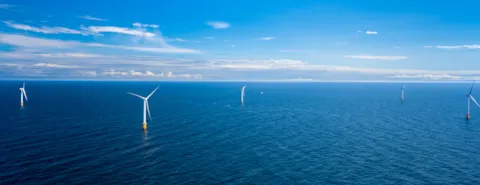The Future of Navigation Safety Risk Assessments on the West Coast
Floating wind, more than bottom fixed, will require early engagement of U.S. Coast Guard and marine stakeholders.
Floating offshore wind infrastructure poses a different risk to navigation than bottom-fixed turbines and will therefore require and different approach. Unlike bottom-fixed structures, such as monopiles and jackets, floating wind turbines are linked to the seabed by mooring lines and dynamic electric cables which are suspended in the water between the surface and the seabed. These elements are specific to floating wind and present new risks that need to be considered in navigation safety risk assessments (NSRAs). The characteristics such as size and depth of these cables can vary significantly depending on the water depth and the technology employed.
One of the new risks that may arise from floating wind is, for instance, the possibility for fishing gear to be snagged in a mooring line or in a high-voltage subsea cable, even when sailing between the turbines. This risk is particularly critical in very deep waters such as California, where the mooring footprint is greater, and where the inter-array cables between the turbines may be suspended (see Figures 1 and 2 below). Such entanglements can lead to vessel accidents, damage to fishing equipment, and disruptions to maritime operations.
For floating wind more than for bottom-fixed, project design has a direct impact on navigation safety. It becomes imperative to consider this aspect early in the development process. One way to address this is by involving NSRA contractors and the USCG in the initial stages of defining the Project Design Envelope (PDE). Potential navigation hazards and safety concerns can only be identified and mitigated proactively with such early engagement, ultimately ensuring the safe coexistence of floating wind farms with maritime navigation. The mooring configuration, in particular, offers multiple concepts with different impacts on the navigation: the type of anchor, the mooring lines configuration (e.g., catenary, taut, Tentionned Leg Platforms), and the material of those lines will affect navigation in different ways. Given our knowledge of current and planned mooring and floating cable technologies, DNV develops specifications of PDEs that are optimized for maximum flexibility for later-stage technology while minimizing risks to navigation during the permitting process decisions.
Figure 1 Main types of mooring systems: (A) Catenary, (B) TLP, (C) Taut/semi-taut
Figure 2 Different types of inter-array cable configurations[1]
This understanding of design impacts on marine safety and their acceptability by the other sea users will require excellent coordination with all marine stakeholders, and particularly the USCG. In April 2023, DNV met with representatives of USCG District 11 at their Oakland Base. USCG’s commander stressed the necessity for the USCG to be involved earlier in the process than what has been done before on the east coast. Early involvement of the USCG during the development of the PDE would help ensure the impacts of the design on navigation safety as well as search and rescue efforts are adequately considered, and would therefore ease the future phases of project permitting.
Figure 3 Example of deep-water floating wind subsea configuration (semi-taut mooring lines and suspended inter-array cables)
Marine traffic patterns on the west coast
Another aspect to consider is the implementation of commercial traffic fairway by the USCG, as visible on the Automatic Identification System (AIS) records. Although marine traffic is generally less dense on the west coast than on the east coast, the current commercial traffic transits right through the offshore wind lease areas, along the west coast and between the ports of Los Angels and San Francisco. In anticipation of this potential risk and as part of the PAC-PARS (Pacific Coast Port Access Route Study), the USCG has proposed traffic fairways further offshore which, if implemented, would push the commercial traffic west of the Offshore Wind Development and would significantly limit the risk posed by the offshore wind development on commercial traffic. However these routing measures would have no effects on the recreational and fishing activities whose interaction with floating wind turbines will require thorough analysis.
Source: USCG
Figure 4 2021 all-vessels AIS traffic (left) and USCG proposed fairways in PAC PARS 2023 (right)
REFERENCES
[1] Izwan Bin Ahmad, Anja Schnepf, Muk Chen Ong, An optimisation methodology for suspended inter-array power cable configurations between two floating offshore wind turbines, Ocean Engineering, Volume 278, 2023
7/19/2023 3:00:00 PM
